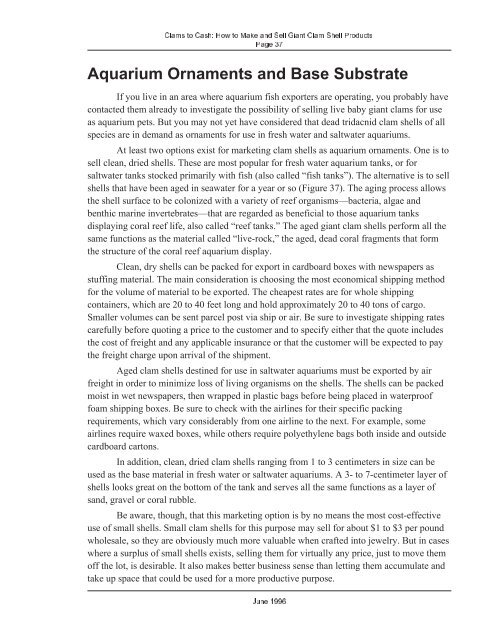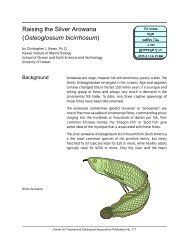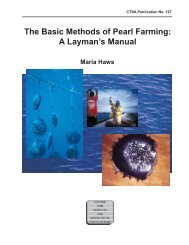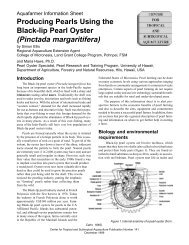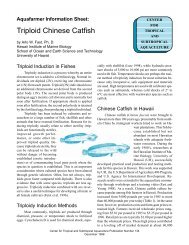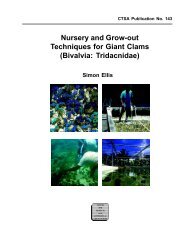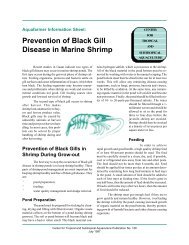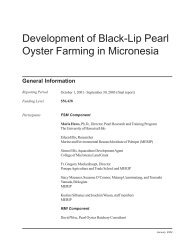Clams to Cash: How to Make and Sell Giant Clam Shell ... - eXtension
Clams to Cash: How to Make and Sell Giant Clam Shell ... - eXtension
Clams to Cash: How to Make and Sell Giant Clam Shell ... - eXtension
- No tags were found...
Create successful ePaper yourself
Turn your PDF publications into a flip-book with our unique Google optimized e-Paper software.
<strong><strong>Clam</strong>s</strong> <strong>to</strong> <strong>Cash</strong>: <strong>How</strong> <strong>to</strong> <strong>Make</strong> <strong>and</strong> <strong>Sell</strong> <strong>Giant</strong> <strong>Clam</strong> <strong>Shell</strong> ProductsPage 37Aquarium Ornaments <strong>and</strong> Base SubstrateIf you live in an area where aquarium fish exporters are operating, you probably havecontacted them already <strong>to</strong> investigate the possibility of selling live baby giant clams for useas aquarium pets. But you may not yet have considered that dead tridacnid clam shells of allspecies are in dem<strong>and</strong> as ornaments for use in fresh water <strong>and</strong> saltwater aquariums.At least two options exist for marketing clam shells as aquarium ornaments. One is <strong>to</strong>sell clean, dried shells. These are most popular for fresh water aquarium tanks, or forsaltwater tanks s<strong>to</strong>cked primarily with fish (also called “fish tanks”). The alternative is <strong>to</strong> sellshells that have been aged in seawater for a year or so (Figure 37). The aging process allowsthe shell surface <strong>to</strong> be colonized with a variety of reef organisms—bacteria, algae <strong>and</strong>benthic marine invertebrates—that are regarded as beneficial <strong>to</strong> those aquarium tanksdisplaying coral reef life, also called “reef tanks.” The aged giant clam shells perform all thesame functions as the material called “live-rock,” the aged, dead coral fragments that formthe structure of the coral reef aquarium display.Clean, dry shells can be packed for export in cardboard boxes with newspapers asstuffing material. The main consideration is choosing the most economical shipping methodfor the volume of material <strong>to</strong> be exported. The cheapest rates are for whole shippingcontainers, which are 20 <strong>to</strong> 40 feet long <strong>and</strong> hold approximately 20 <strong>to</strong> 40 <strong>to</strong>ns of cargo.Smaller volumes can be sent parcel post via ship or air. Be sure <strong>to</strong> investigate shipping ratescarefully before quoting a price <strong>to</strong> the cus<strong>to</strong>mer <strong>and</strong> <strong>to</strong> specify either that the quote includesthe cost of freight <strong>and</strong> any applicable insurance or that the cus<strong>to</strong>mer will be expected <strong>to</strong> paythe freight charge upon arrival of the shipment.Aged clam shells destined for use in saltwater aquariums must be exported by airfreight in order <strong>to</strong> minimize loss of living organisms on the shells. The shells can be packedmoist in wet newspapers, then wrapped in plastic bags before being placed in waterprooffoam shipping boxes. Be sure <strong>to</strong> check with the airlines for their specific packingrequirements, which vary considerably from one airline <strong>to</strong> the next. For example, someairlines require waxed boxes, while others require polyethylene bags both inside <strong>and</strong> outsidecardboard car<strong>to</strong>ns.In addition, clean, dried clam shells ranging from 1 <strong>to</strong> 3 centimeters in size can beused as the base material in fresh water or saltwater aquariums. A 3- <strong>to</strong> 7-centimeter layer ofshells looks great on the bot<strong>to</strong>m of the tank <strong>and</strong> serves all the same functions as a layer ofs<strong>and</strong>, gravel or coral rubble.Be aware, though, that this marketing option is by no means the most cost-effectiveuse of small shells. Small clam shells for this purpose may sell for about $1 <strong>to</strong> $3 per poundwholesale, so they are obviously much more valuable when crafted in<strong>to</strong> jewelry. But in caseswhere a surplus of small shells exists, selling them for virtually any price, just <strong>to</strong> move themoff the lot, is desirable. It also makes better business sense than letting them accumulate <strong>and</strong>take up space that could be used for a more productive purpose.June 1996


